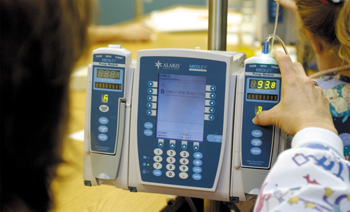
The new IV pump automatically alerts nurses to dosage errors. (photo by Dana Johnson)
IV pump prevents mistakes
Years of collaboration between Vanderbilt University Medical Center and California-based intravenous infusion pump maker Alaris Medical Systems have resulted in a new IV pump that automatically checks drug and dosage information to alert nurses to any potential medication error. Vanderbilt will be the second medical center in the world to use the new pump. Roughly 95 percent of VUH patients are placed on an IV pump at some point during their hospital stay.
“I think this is the most powerful patient safety advance I’ve ever seen,” said Irene Hatcher, coordinator of Clinical Pathways and Case Management, one of those at Vanderbilt who helped develop the Alaris Medley pump. VUMC has been aiding development of the pump for eight years, with contributions coming from nursing, physicians, biomedical informatics and the pharmacy. Jim Hutchinson, director of Biomedical Electronics, led Vanderbilt’s part in the project.
Like other pumps, the Alaris is with each use reset by a nurse to deliver a particular drug at a particular rate. Conventional IV pumps can be reset to deliver a drug at any rate from .1 to 999 milliliters per hour. Volumes meant to be delivered over 24 hours can mistakenly be set to be delivered in one hour, with devastating results.
Unlike conventional pumps, the new pump gives nurses, at the point of drug administration, a safety feature similar to what WizOrder gives to doctors at the point of drug ordering: It alerts the user to any dosage that appears wrong. As the nurse enters dosage information on the pump’s keypad, a drug library is at work in the background, checking minimum and maximum doses. The pharmacy has worked with VMG doctors to determine these dosage limits. The limits for a given drug can be set differently for different areas of the hospital—adult intensive care, adult general care, pediatric intensive care and so on. For each drug the pump can accept both “soft” dosage limits that the nurse can override and “hard” dosage limits that cannot be overridden.
Other advantages of the new pump are easier use (fewer keypunches and decision points) and a lightweight design. The new pump is also modular, allowing it to be configured to deliver from one to four channels (conventional pumps come in one-, two- and four-channel varieties). Biomedical electronics is working on a solution for wireless reprogramming of pumps in VUH supply rooms. It’s anticipated that one day doctors will be able to program the pump as they order the medication in WizOrder.
The pump and its safety software have been in testing in the VUH trauma unit and pediatric intensive care unit for more than a year. Hatcher said the pump is having a considerable positive impact on nurse job satisfaction in those areas.
VMG will use the pumps in outpatient areas beginning March 13, and all of VUH will follow on March 19. Clinic and hospital staff training began in February.













